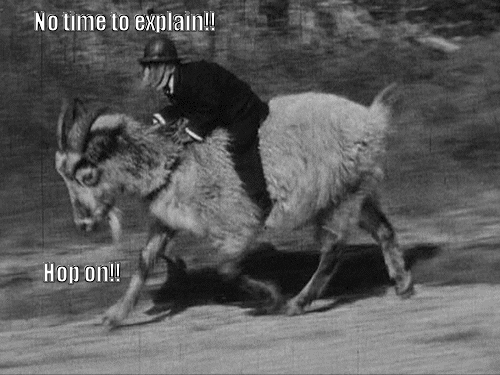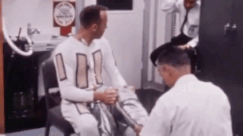
TODAY IN HISTORY | April 9th
Welcome to another edition of Today In History, where we explore the history, conspiracies, and the mysteries that have shaped our world.
🐴🚓 First, we’re heading to 1866, when future president Ulysses S. Grant was arrested—for speeding. That’s right—Grant was pulled over in Washington, D.C., not for reckless driving in a car, but for riding his horse-drawn carriage a little too fast. The arresting officer actually let him off with a warning the first time, but when Grant was caught again the next day, he was arrested and fined. Even war heroes, it turns out, aren’t above the law—or the speed limit.
🚀👨🚀 Then, in 1959, NASA introduced its first group of astronauts: the Mercury Seven. These seven men—including names like John Glenn and Alan Shepard—became instant national heroes and the faces of America’s push into space. Handpicked from military test pilots, they were brave, smart, and ready to take on the unknown. This moment kicked off the U.S. space program and laid the foundation for one of the most ambitious chapters in human exploration.
Let’s dive into some history!🌎

TODAY’S TOPICS
1866 - Ulysses S. Grant Arrested For Speeding
1959 - NASA Introduces The First Astronauts
Extras
Mona Lisa Theif🎨
CIA vs Castro’s Beard🕵️♂️
Topsy The Elephant🐘
Basil and Scorpion Soup🍲

1866 Ulysses S. Grant Arrested🚔
On April 9, 1866, just a year after leading the Union to victory in the Civil War, General Ulysses S. Grant got arrested in Washington D.C.—for speeding. But this wasn’t in a car, obviously. He was flying through the streets in a horse-drawn carriage, going way too fast for the local police’s liking. Yep, even national war heroes could get ticketed for reckless driving... horse edition.

Ulysses S. Grant and his horse
This wasn’t even Grant’s first offense. He had a bit of a rep for hauling through the streets in his carriage, and D.C. cops had already warned him a few times. The officer who finally had enough was William H. West, one of the few Black officers on the force at the time. West pulled Grant over, told him he was speeding again, and—shockingly—put him under arrest. Grant, to his credit, didn’t pull the “Do you know who I am?” card. He actually respected the arrest and even paid the fine.

William H. West
There are a few versions of how the arrest went down, but they all agree: Grant didn’t fight it. He handed over the reins of his horse, promised to appear in court, and later paid a $20 fine. The whole thing became kind of a legendary “only in America” moment—where even a top general, and future president, got held accountable for breaking the law.

And honestly, it says a lot about both men. Grant could’ve made a scene, but instead, he owned it. Officer West, meanwhile, became a low-key folk hero for sticking to the rules, no matter who was in the driver’s seat. It’s probably the classiest horse-speeding ticket in history.
🤖 Ai Depiction of Event

On To The Next Story!!!

1959 NASA’s First Astronauts🚀
On April 9, 1959, NASA held a press conference and introduced the original seven astronauts of the U.S. space program, later nicknamed the Mercury Seven. These were the first Americans officially chosen to go into space, and they were picked less for their star power and more for their flight skills—every single one was a military test pilot with serious experience (and serious nerves of steel).

The lineup? Scott Carpenter, Gordon Cooper, John Glenn, Gus Grissom, Wally Schirra, Alan Shepard, and Deke Slayton. NASA picked them from over 500 candidates. These guys had to be under 40, shorter than 5’11”, in peak health, and have at least 1,500 hours of flying time. Basically, the most elite of elite. They were trained to handle extreme G-forces, isolation chambers, zero gravity, and all the unknowns of space travel—none of which existed just a few years earlier.

At the time, the U.S. was deep in the Cold War space race with the Soviet Union, and the pressure was on. The Soviets had just launched Sputnik in 1957 and were getting all the early wins. America needed to catch up, and these seven guys were going to be the faces of that mission. The media ate it up—suddenly astronauts were celebrities, with magazine covers, TV interviews, and even action figures.

Over the next few years, they each played key roles in the early space program. Alan Shepard became the first American in space in 1961. John Glenn was the first American to orbit the Earth in 1962. And all of them helped pave the way for the Apollo missions that eventually landed on the Moon. But it all started with that press conference on April 9—seven dudes in matching suits, ready to launch into the unknown.
🤖 Ai Depiction of Event




Mona Lisa Theif🎨
The Mona Lisa was actually stolen in 1911, and for two years, no one knew where she was. The thief? Vincenzo Peruggia, an Italian handyman who believed the painting belonged in Italy, not France. Disguised as a museum worker, he hid in a broom closet overnight, then walked out of the Louvre with the Mona Lisa under his coat the next morning. France was shocked, suspects included Pablo Picasso, and for a while, people thought the painting might be lost forever. But in 1913, Peruggia tried to sell it to an art dealer in Florence, who immediately alerted the police. The Mona Lisa was recovered and returned to the Louvre—where she’s been under tight security (and glass) ever since. The heist made her world-famous—so you could argue that the theft helped make the Mona Lisa a true icon. 🖼️🔒🇫🇷

CIA vs Castro’s Beard🕵️♂️
During the Cold War, the CIA cooked up all kinds of “creative” plots to take down Fidel Castro—including one to make his iconic beard fall out. Why? The beard wasn’t just facial hair—it was part of Castro’s image, a symbol of rebellion and charisma. The idea was to secretly dust his clothing or shoes with a depilating chemical, causing him to lose his beard and credibility in the eyes of the Cuban people. It never happened (thankfully?), but it’s one of many bizarre schemes the CIA brainstormed—others included exploding cigars, poisoned wetsuits, and even a fake underwater Jesus. When it came to Cold War espionage, nothing was too weird—not even follicular sabotage. 🧔➡️❌🕶️

Topsy The Elephant🐘
In 1903, an elephant named Topsy was electrocuted at Luna Park in Coney Island, and Thomas Edison’s name often gets linked to the incident—but the story’s more complicated than that. Topsy had a troubled history in captivity and was sentenced to death after several incidents with handlers. The owners decided to make a public spectacle of her execution (yes, this was a thing in 1903). She was given poisoned carrots, strangled, and finally electrocuted with 6,600 volts of AC current. The event was filmed by Edison’s company, which is where the connection to Edison comes from. However, Edison himself wasn’t directly involved, and by that time, his rivalry with Tesla and Westinghouse over AC vs. DC current had mostly cooled off.🐘💔⚡

Basil and Scorpion Soup🍲
In medieval Europe, people believed some wild things about herbs—and one of the weirdest was that basil could breed scorpions. The idea was that if you left a pot of basil under the right conditions (like under a brick or clay pot for too long), it would somehow generate scorpions. Some even claimed that smelling basil too much could make scorpions form in your brain. Seriously. Where did this come from? Likely a mix of ancient superstition, misunderstood natural science, and the basil plant’s exotic reputation (it wasn’t native to much of Europe at the time). Thankfully, modern basil just makes great pasta—not arachnid surprise parties. 🌿🍝❌🦂
Pop Quiz 📝

What does “The Magna Carta” mean?
Would You Rather?🧐

Would you rather be in the room when Thomas Edison invented the lightbulb or when the Wright brothers took flight?
If you enjoy this edition of Today In History be sure to send it to a friend and force them to sign up because that’s what good friends do. Until next time, stay curious, question everything, and keep uncovering the mysteries of the past.